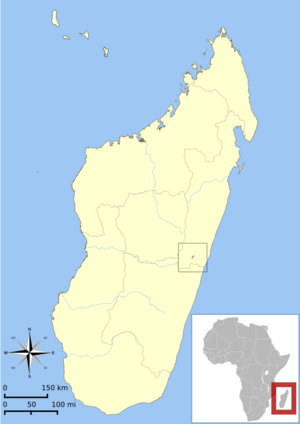Marohita mouse lemur facts for kids
Quick facts for kids Marohita mouse lemur |
|
|---|---|
| Conservation status | |
| Scientific classification | |
 |
|
| Distribution of M. marohita |
The Marohita mouse lemur (Microcebus marohita) is a tiny mouse lemur that lives only in the Marohita Forest in eastern Madagascar. This forest is close to a village called Marolambo.
Scientists first found these lemurs in December 2003. Their discovery was announced in 2013. At the same time, another new lemur, the Anosy mouse lemur, was also announced. The Marohita mouse lemur is quite large for a mouse lemur, weighing up to 89 grams (about 3 ounces). It shares its home with three other mouse lemur species: Goodman's mouse lemur, Simmons' mouse lemur, and the brown mouse lemur. All four species look almost exactly alike!
The Marohita mouse lemur has reddish-brown fur on its back. Its belly fur is grayish-beige. We don't know much about how these lemurs behave in the wild. Sadly, this species is considered Critically Endangered. This means it is at a very high risk of disappearing forever. Its only known home, the Marohita Forest, has been badly damaged over the years.
Contents
Discovering the Marohita Mouse Lemur
The first Marohita mouse lemurs were found by a biologist named Rodin Rasoloarison. He was doing field work in December 2003. He caught three mouse lemurs in the Marohita Forest. This forest is in the Toamasina Province of eastern Madagascar.
These lemurs were carefully prepared as biological specimens. This included their skins, skulls, and tissue samples. All the necessary permits were obtained from the government of Madagascar.
The Marohita mouse lemur was officially described in 2013. This happened at the same time as the Anosy mouse lemur. Mr. Rasoloarison worked with other researchers like David Weisrock and Anne Yoder. They used special molecular analysis to study the lemurs' DNA. This helped them figure out that these were new species.
The Marohita mouse lemur belongs to the group of animals called Microcebus. This group is part of the Cheirogaleidae family. The first lemur specimen collected is called the holotype. It was found on December 2, 2003, in Marohita Forest. The species name, marohita, comes from the forest where it was found. In the Malagasy language, "marohita" means "many views."
Even though the Marohita mouse lemur lives near other mouse lemur species, scientists found no signs of them mixing. This means they are considered a separate species. Many eastern mouse lemurs look very similar. This makes them cryptic species, meaning they are hard to tell apart just by looking.
What Does It Look Like?
The Marohita mouse lemur has a reddish-brown coat on its back. It has a faint stripe down its back. The fur on its belly is grayish-beige. The fur underneath is dark gray.
These lemurs are about 27.5 to 28.6 centimeters (10.8 to 11.3 inches) long from head to tail. Their tail is about 13.3 to 14.5 centimeters (5.2 to 5.7 inches) long. This means their tail is roughly half their total body length. They have short ears, about 1.8 to 1.9 centimeters (0.7 to 0.75 inches) long. Their hind feet are long, measuring 3.4 to 3.5 centimeters (1.3 to 1.4 inches).
The Marohita mouse lemur is one of the largest mouse lemurs known. It can weigh up to 89 grams (3.1 ounces). A young male Marohita mouse lemur found was as big as the largest known adult male Gerp's mouse lemur. Female Marohita mouse lemurs were even heavier. They were 20% heavier than the heaviest females of other species like Simmons' mouse lemur and Gerp's mouse lemur.
Behavior and Life Cycle
Unfortunately, scientists do not have much information about the Marohita mouse lemur's behavior. We don't know how they communicate, what they eat, or how they reproduce. More research is needed to understand their daily lives.
Where It Lives and Its Habitat
The Marohita mouse lemur has only been found in the Marohita Forest. This forest is part of the larger Marolambo Forest. We don't know if they live anywhere else.
Other mouse lemur species live nearby. For example, Goodman's mouse lemur lives north of the Mangoro River. Gerp's mouse lemur also lives in the lowlands north of the river. South of Marolambo, you can find Jolly's mouse lemur and the brown mouse lemur.
Conservation Status
The Marohita mouse lemur is in serious trouble. Its home, the Marohita Forest, has been severely damaged. This damage happened a lot between 2003 and 2012.
Because of this habitat loss, the International Union for Conservation of Nature (IUCN) evaluated the Marohita mouse lemur as Endangered in 2012. This was even before the species was officially described! In 2014, its status was updated to Critically Endangered. This means it faces an extremely high risk of extinction in the wild. Protecting its forest home is very important for its survival.


